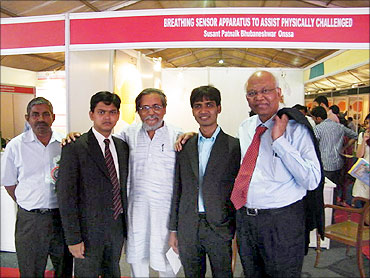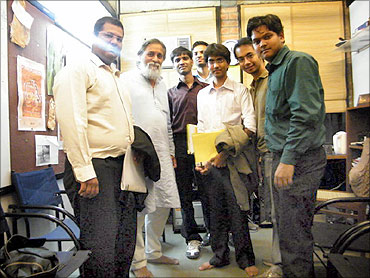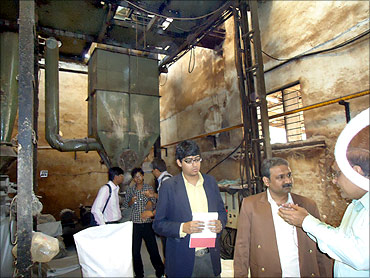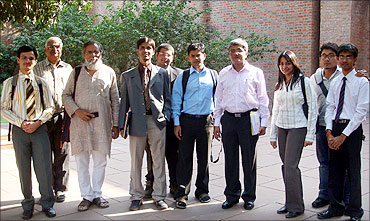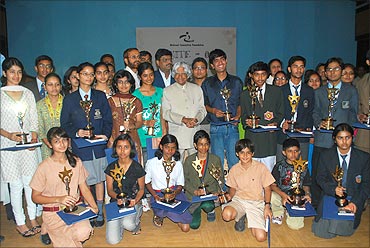 | « Back to article | Print this article |
10 steps to drive the 'Decade of Innovation'
We must accept that one of the greatest tragedies of modern India is not challenging the youth and other institutions intensively enough, says Anil K Gupta.
If various technical universities continue to take interest as is evident now, it won't be difficult to imagine that such a platform may have more than a million projects and ideas in a few years time.
Gujarat Technical University has decided to set up Navsarjan Sankul (Innovation Clusters) in which different technical institutions have been mapped to different MSME industrial clusters.
It is well known that most jobs are generated by micro-, small- and medium-enterprises (MSMEs) and informal sector. And if their ability to generate jobs has to be sustained and invigorated, then infusion and implosion of innovations is inevitable.
There are several ways in which the innovation eco system can be made vibrant. These alternatives are also challenges.
I hope that young students and cluster coordinators will join hands in creating a new momentum for inclusive growth in this 'Decade of Innovation'.
The only thing that will become casualty is the inertia. Let the sceptics celebrate their inertia, even as the entrepreneurs and young innovators ignite fireflies of creativity as has been attempted by the Honey Bee Network for so long.
Click NEXT to read on . . .
Photographs: National Innovation Foundation
Part 1: Innovation: 1 lakh projects for low-cost solutions
Anil K Gupta is a professor at IIM Ahmedabad, Co-ordinator SRISTI and Honeybee Network, and Executive Vice Chair, National Innovation Foundation.
10 steps to drive the 'Decade of Innovation'
The first aspect is benchmarking the current level of energy, material and technology youths in the enterprise.
Second, is to identify any innovation that the MSME unit may have tried.
Third is to identify the unsolved problems. And the fourth is to identify the policy bottlenecks which are coming in the way in realizing fully the entrepreneurial potential.
GTU has provided three credits for identifying the problem at the end of the third year and four credits for solving it in the fourth year by every student.
Click NEXT to read on . . .
10 steps to drive the 'Decade of Innovation'
Rajasthan Technical University has also shown interest in taking the model forward in their own way.
Several other states are testing the idea and hopefully will join hands. It is expected that Ministry of Science and Technology and Micro, Small and Medium Enterprises may also find this platform worthy of joining hands in due course.
In any case, the clusters have to have the hunger to engage with young minds in technology institutions.Click NEXT to read on . . .
10 steps to drive the 'Decade of Innovation'
The second challenge is to identify the existing projects which as such or by pooling several projects can solve the existing problem.
Since the academic-industrial linkage has not been very vibrant in most states, this identification will not happen automatically. Workshops will have to be organised in each cluster to facilitate such identification.
Click NEXT to read on . . .
10 steps to drive the 'Decade of Innovation'
GTU has already identified about 100 PhD holding faculty members who may volunteer for the purpose. In addition, they will also help in meeting the next challenge.
Click NEXT to read on . . .
10 steps to drive the 'Decade of Innovation'
These reviews will reveal the strengths, weaknesses, gaps and also the potential for pooling different ideas within a vertical or across domain specific verticals for exploiting full potential.
Click NEXT to read on . . .
10 steps to drive the 'Decade of Innovation'
For instance, development of devices for manual paddy transplantation or picking tea leaves so as to reduce the drudgery, improve the efficiency and thus the wages of millions of women who do this in a painstaking manner.
Click NEXT to read on . . .
10 steps to drive the 'Decade of Innovation'
The funds for both the purposes are scanty if at all. One can easily aim at least 2000 patents from each technical university every year.
That will transform the stagnancy and sluggishness in the patent filing rates of Indians in India.
One should think of either a utility patent system similar to Australian model or what we have called INSTAR. The idea is to provide quick registration, short term protection, maximum five claims and low fees.
If NIF can file several hundred patents for school or college dropouts with very limited resources, there is no reason why technology students cannot do it.
It is true that most of them lose interest in their projects after passing out.But, the society has to have interest in their projects.
Click NEXT to read on . . .
10 steps to drive the 'Decade of Innovation'
Unlike the low tech IT outsourcing business, in future platform like techpedia.in would enable high tech outsourcing with the distributed management of knowledge and ideas with high degree of redundancy.
Imagine the cost of assigning same problem or different modules of same problem to hundreds and thousands of students.
The competition and collaboration among the students will generate not only new solutions but many more new heuristics which will spawn further ideas and innovations.
This model of collaborative and competitive problem solving will achieve results at an extremely low cost which is unimaginable in the current costing structure.
The frugal, affordable, accessible and accountable innovations will emerge from the mind fields of technical universities, colleges and labs in small towns as well as bigger metros.
Click NEXT to read on . . .
10 steps to drive the 'Decade of Innovation'
By offering attractive awards, prizes, risk capital, stakes and other incentives, the whole eco-system can be made vibrant and at the same time joyfully collegial and inclusive.
Click NEXT to read on . . .
10 steps to drive the 'Decade of Innovation'
With planned failure of 90 per cent, the success of the remaining will inevitably follow.
We must accept that one of the greatest tragedies of modern India is not challenging the youth and other institutions intensively enough.
The rhetoric of India being a young country with practically no engagement of the policy makers with the technology and management youth shows the farce of the current polity.
Click NEXT to read on . . .
10 steps to drive the 'Decade of Innovation'
The second implies a case where school children will ideate, college students will fabricate and the entrepreneurs and companies will commercialise or diffuse solutions socially as open source.
This is an inverted innovation model which has already been operationalised by NIF through IGNITE competitions.
Indian innovation eco-system is waiting to move vigorously, a small nudge here and a small prick there will make elephants dance and donkeys give way.

